With the current inflation, the prices of tomatoes are constantly increasing. Buying such costly and yet tasteless tomatoes is not worth it.
So, is there an alternative? Yes, there is!
You can grow juicy and tasteful tomatoes in your homes. Yes, even in urban settings where there is no soil or garden area available. This is possible through the hydroponic culture technique.
Hydroponic tomatoes sound like something only the experts can grow, but this is not true. Anyone with no prior experience in hydroponics can grow them without any difficulty.
Read our complete guide to understand the entire process in detail.
Before discussing how to grow hydroponic tomatoes, let’s first understand why should we grow tomatoes hydroponically instead of traditionally.
Table of Contents
Why Grow Tomatoes Hydroponically?
When soil-grown tomatoes are present in such abundance, and techniques to grow them are well established.
then why bother growing tomatoes hydroponically?
There are plenty of reasons to grow hydroponic tomatoes, the first and foremost being the lack of space to practice soil gardening.
The other valid points are as follows
They are easy to grow
Growing tomatoes in the soil is not child’s play. You need expertise to grow crops that really are both nutritious and appetizing. It is difficult to grow a chunky and juicy tomato on your first try.
This is because the soil contents of all areas are different. Hence, there are no specific standards when dealing with such unique conditions.
However, when it comes to hydroponics. The conditions are almost always similar for all users. This is because everything in the hydroponic method is under our control.
All you need is to have a basic understanding of how hydroponics work, and then just follow our guide to grow the best homegrown tomatoes.
You can grow them all season!
Tomato is a summer crop that requires a lot of sunlight and warmth to grow.
Hence, it is impossible to grow it in cooler temperature regions, as well as in cooler times of the year, under normal conditions.
So, even if you are growing tomatoes in soil, they won’t last till winter, when they are actually costly.
Moreover, the tomatoes you find in the market outside its growing season are stored for months, making them lose their flavor.
The solution to all these problems is growing hydroponic tomatoes. In hydroponics, you can grow any plant at any time of the year.
You can grow fresh tomatoes even when it’s snowing outside!
They Consume less water
Water is an ever-decreasing commodity. More and more regions will face freshwater shortages in the coming decades.
Under such conditions, it is our responsibility, to minimize the use of water.
A tomato plant on average consumes 214 liters of fresh water to produce 1 kg of tomatoes.
Not all of this is used by the plant; most just evaporates or seeps into the soil. Tomato plants’ roots can absorb water up to a certain depth.
While in the hydroponic system, the water pump recycles the same water again and again. This minimizes water loss.
You can grow them Indoors!
Modern homes in urban areas rarely have a dedicated gardening area now.
Moreover, not everyone can afford expensive, large homes with lawns and gardens.
But everyone deserves to be able to grow tomatoes indoors!
Growing hydroponic tomatoes is the answer to this problem. Hydroponic tomatoes not only solve the problem of the land but also save us from adverse weather conditions such as snow, heat, etc.
How To Grow Tomatoes Hydroponically?
After understanding the importance and need of growing hydroponic tomatoes, let’s understand how to grow hydroponic tomatoes.
Either Seed or Seedling
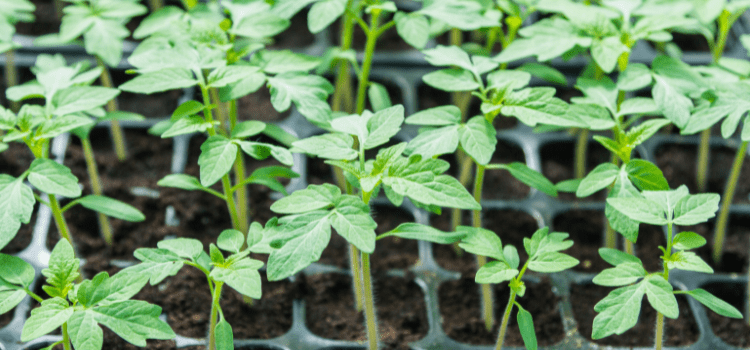
You either need a seed or a seedling to start your journey of growing tomatoes hydroponically.
In the case of seeds, you first need to germinate them. You can understand how to germinate hydroponic seeds with different growing media from our guide.
As a beginner grower, starting out with small plants is much easier. You can buy germinated seedlings from the market and now all that remains is to transfer them to your hydroponic system.
However, seedlings are more expensive than seeds. But convenience comes at a cost, doesn’t it?
Choose a Growing medium
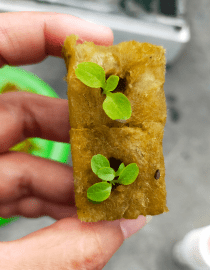
Hydroponic tomato seeds germinate in a growing medium instead of soil.
There are different growing media with different characteristics that you can use as per your budget and need.
Normally, rockwool is used for tomato plants. But there are other alternatives to it too.
Check out our article on these affordable alternatives to rockwool and choose the best growing media for your tomato plants.
Use A Reliable Water Source
A water source can be a tap that brings fresh water, or you can simply add water manually with a bucket.
What the source of water is does not really matter as long as the water is fresh, clean, and has neutral pH.

Water tank To Store Water
This is a large water container that goes below the plants. The tomato plant roots are submerged in this water tank.
Moreover, the water pump pushes the water upwards to floor the whole plant too.
This helps plants grow efficiently as they absorb the nutrient solution from leaves as well.
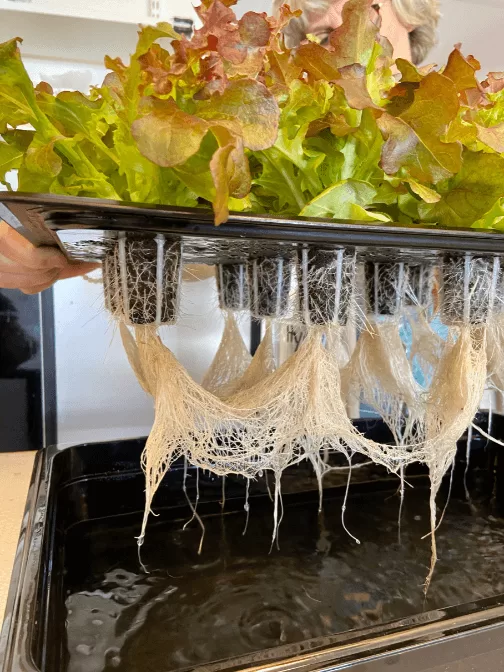
Growing Tray To Keep The Plants
This is a tray in which the hydroponic tomatoes stay while a nutrient solution bathes their roots. There are large trays that can carry a number of plants at a time.
There are perforations that allow roots to pass through them, while the plant body stays up. They come in different sizes, that users can choose as per their needs.

Trellis Keeps The Plants Upright
Growing tomato plants without support is not possible, even in the soil. Then, this would definitely be not possible for hydroponic tomatoes, which are already soilless.
Therefore, tomato plants need trellises as support to stand straight for growth.
These ensure that the plants upwards, while the roots stay down for nutrient and water absorption.

Water Pump To Circulate The Water
This is one of the most important parts of the hydroponics system. This pumps water from the reservoir to when it is actually needed; plants and plants roots.
Without a water pump, growing tomatoes hydroponically is not possible, as the water will go stale and microbes may appear in it.

Choose A Hydroponic System
There are many hydroponic systems, all of which can support growing hydroponic tomatoes. However, each one has its pros and cons.
Selection depends entirely on your needs and expertise in hydroponic growing. Following are some important hydroponic systems and their characteristics.
Ebb and flow system
This is considered the best hydroponic system for first-time growers.
In this hydroponic system, the water is flooded to wash the whole tomato plant body. It nourishes them with the nutrient solution.
When the water level reaches as high as 2 inches below the water tank, it automatically drains back into the reservoir, preventing overflowing. This is basically a flood and drain system.
The ebb and flow system is simple and easy to use. You can find the whole kit from the hydroponic stores or can buy the individual components separately and then assemble them together.
NFT Hydroponic system
Helps in growing tomatoes hydroponically in large batches. This is a little more complex to use, but the yield is very high.
NFT stands for nutrient film technique. In this hydroponic system, a thin film of the nutrient solution is always present around the plant’s roots. The nutrients dissolved in water are pushed by the water pump to the plant roots.
Water goes to the roots, which are inside a whole tube, and ends up falling back into the same reservoir. From there, it is again used, making it a very water-efficient hydroponic system.
This ensures that hydroponic tomatoes have access to the nutrient solution at all times. In this, tomato plants have higher nutrient absorption, more airflow, and hence more yield. Though a little more costly, this system makes growing tomatoes look like a fun task.
Choose Types of Seeds
You might just them as “tomatoes”, but there are actually more than 10,000 different types of tomato varieties.
However, 7 are the most popular and commonly used.
You better do a little research as to which type of tomato plants you need. Then buy the tomato seeds of the required variant.
Without proper knowledge, you can even end up buying seeds of some bitter-tasting variety.
Some commonly used tomato varieties are:
- Cherry tomatoes
- Grape tomatoes
- Roma tomatoes
- Beefsteak tomatoes
- Green tomatoes

Some Important Factors
A quick care sheet!
| Factors | Optimum Values |
| Light | 12 – 16 hours of light (Natural or Artificial) |
| Water | Top off water every 2–3 days, and complete change after 15–20 days. |
| Nutrients | Requires very less N, while high conc. of P and K is needed. Micronutrients like B, Cl, Cu, Fe, Mn, Mo, and Z are required in conc. of 0.44, 0.85, 0.05, 0.62, 0.06 and 0.09 respectively. |
| Temperature | The ideal temperature range of a growing tomato plant is 65 °F – 85 °F range |
| pH | The ideal pH range for maximum growth is 5.5 – 6.3 |
| Pruning | Prune the lateral branches to 2 – 2.5 mm every week. |
Plants face different factors like pH, temperature, weather, nutrient contents, light, etc. when growing in the soil. However, when growing indoors, most of these factors are to be maintained by the grower.
In a hydroponic garden, this is one step ahead. Here, tomatoes grow in a highly controlled environment. It means that all the otherwise environmental facts are set at standards that are ideal for the maximum growth of the plant.
pH
Tomato plants grow best in the pH range of 5.5 – 6.3 and are very susceptible to the change in pH of water, growing media, or whatever nutrient solution they take in.
Therefore, it is advisable to keep a pH test kit and check the pH of water both before and after adding the nutrients.
If you notice the tips of your tomato leaves burning from the tips, it means that the water pH is less than 5.5
And if there is marginal yellowing of leaves, then the pH is more than 6.3, and immediately needs to be rectified before the damage becomes irreversible.
Temperature
Since tomato is a summer crop, they like higher temperature. The ideal temperature range for growing tomato plants is 70°F to 90°F.
Therefore, the same temperature must be maintained with the hydroponic system either by artificial means or natural way. It is better and easier is an artificial thermostat is installed for the plants.
During germination, the ideal temperature range is 65°F to 85°F.
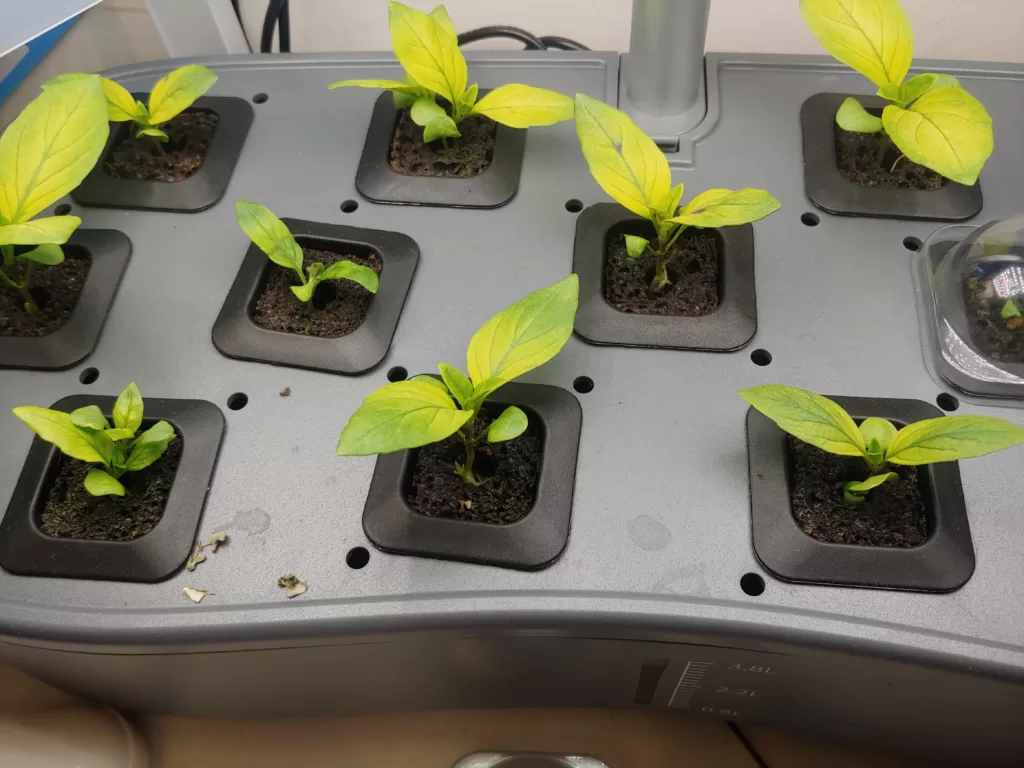
Nutrients
Since hydroponics do not contain soil, they lack dissolved soil minerals and nutrients as well. Instead, they have water as growing media, which does not contain any dissolved nutrients naturally.
So, we need to add the nutrients ourselves into the water. Then the nutrient solution formed is taken up by the plant roots and used in different metabolical processes to grow hydroponic tomatoes.
Light
Light is an integral part of growing any plant. When we grow tomatoes indoors, light is still a must and is often provided through led grow lights.
Led grow lights are in many ways better than sunlight, except for the cost factor. Artificial lights can provide light to plants for as long as needed, irrespective of the environmental conditions.
Tomato plants grow best when 12 – 16 hours of light is provided to them.
When and how to cultivate
It is really easy to notice when the tomatoes are ripe. Some of the symptoms are the following.
Check if tomatoes are ripe – their color is mostly different from unripe ones. When you see no spot left of the unripe color, then it means that the fruit has ripened.
They come off really easily, without needing much twisting.
They are visually very shiny, like having a layer of wax.
Ripened tomatoes feel a little soft when touched, contrary to a common misconception that they must be very firm. They should be neither too tight, nor squishy.
If everything goes alright, large sized varieties like green tomatoes ripen after 65–70 days, while small varieties like cherry tomatoes ripen after 40–45 days.
After you notice these symptoms, then it’s a sign that you should begin harvesting without any delay.
Top 3 tomato fertilizers in the market
1. Masterblend 4-18-38 tomato & vegetable fertilizer
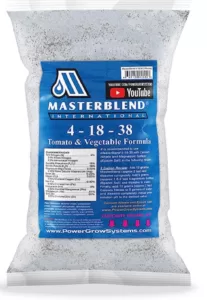
This is the most widely used fertilizer for hydroponic tomatoes. Tomato variety, grow hydroponic tomatoes.
The right amount of phosphorus and nitrogen ensures that your tomato plants will have more tomatoes and fewer useless leaves.
To prepare 5 gallons, add 2 tablespoons of nutrient mix to water and stir until dissolved. Then add 2 tablespoons of magnesium sulfate and again stir until dissolved.
Finally, add 2 tsp of calcium nitrate and stir the whole mixture. Remember the 2-2-2 formula; 2 tsp of all compounds.
However, plants cannot take this up directly. Epsom salt (magnesium sulfate) and calcium nitrate need to be in the solution before adding this nutrient mix. Then the whole solution is added to the plant.
2. Tomato Fertilizer 4-18-38 Powder

Though the nutrient concentration ratio of 4-18-38 is the same, but this one is highly concentrated and can make up to 400 gallons of nutrient solution.
Besides the essential nutrients, it also contains all the necessary micro and macro nutrients vital for the ideal growth of the plant. This is especially advised for cherry tomatoes to make them plump and juicy.
This is a stand-alone formula. All you need is to add 1 or 2 tablespoons of the mix in 5 gallons of water in the hydroponic tank. Now, just wait for your cherry tomato plants to grow magically.
3. GreenLoop Hydroponic Nutrients

Greenloop hydroponic nutrients contain a set of 2 mixes. One is solid and is much more concentrated than the other one, which is semi-solid. The contents of these bottles make 2 liters of concentrate. This can be diluted as per the required strength of the nutrients.
Adding 100 liters of water would make a concentrated nutrient solution with full strength. Adding 200 liters would make the nutrient solution with only half-strength.
The less concentrated solution is used in the initial stages of plant growth. On the onset of fruiting, the solution with full strength is given to the plant for maximum growth.
Plant Care Instructions
Pruning
First, why do we need pruning at all? Because without it, the plant will grow more laterally than in an upwards direction. We need more fruit and fewer leaves.
Therefore, when the plant is young, the lateral branches are removed leaving only the main stem. After upward growth has reached a limit, then remove the side branches from 2 to 2.5 mm each week.
With fewer branches, the costly nutrients we’re using to grow tomato plants will be used for the right purpose, to grow fruits, and not just leaves.
The tomato branches are delicate and can be removed simply by hand without needing any special pruning tools.
Disease inspection and control
One of the main advantages of growing tomatoes hydroponically is that it is safe from many of the microbes and pests that normally attack the soil plants.
Since the hydroponic tomato plants are kept hygienic and clean, they rarely get any microbes or pests.
However, they can get diseases from the lack or abundance of nutrients, too acidic or basic soil, lack of water, etc.
They can be inspected easily due to the appearance of related symptoms on the plant.
When growing tomatoes, the main concern is to keep the plants healthy. Because only then will you be able to get the fruits that will in turn keep you healthy.
Conclusion
Now that you know how to select seeds, different tomato types, and the apparatus needed, you have an in-depth understanding of how to grow hydroponic tomatoes.
However, there might be things that you cannot understand in the article. They will make sense once you grow your hydroponic tomatoes practically.
So, you better start now, and if you feel confused at some point, take help from this guide.
Once you’re able to grow own hydroponic tomatoes, you can enjoy homegrown delicious tomatoes any time of the year.
1 thought on “Grow Hydroponic Tomatoes – A Beginner’s Guide”